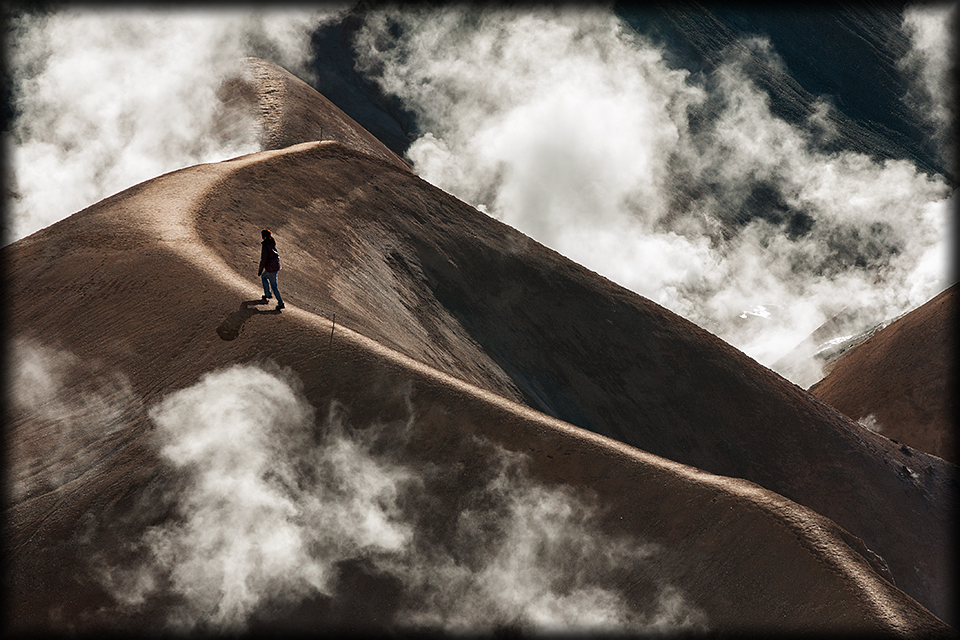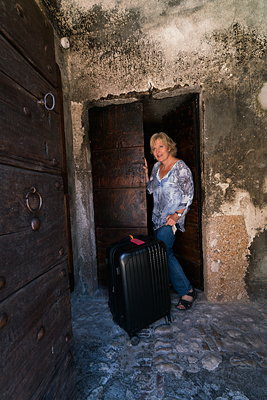
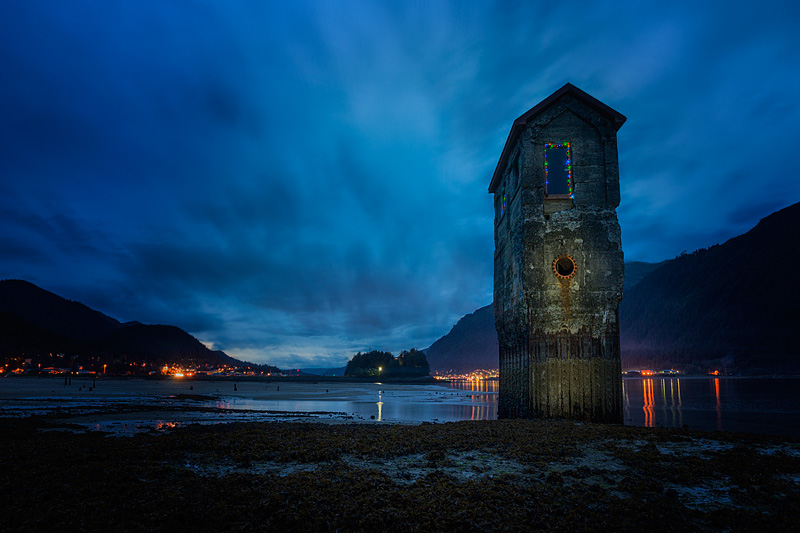
Treadwell Mine salt pump at night, Juneau, Alaska
When I visited Juneau, Alaska in August, I knew that I wanted to photograph the Treadwell Mine Salt Pump, a ruined structure that sits in the water between downtown Juneau and Douglas Island. Reading about the historic mine and seeing pictures of this unusual structure intrigued me. So I planned out my shooting times and itinerary before I flew to Alaska.
Some photographers prefer to go with the flow. It is nice to have the flexibility to see what develops—and just wing it. But I’m a planner. I like to know what my photographic options are, far in advance. Let’s face it, travel is expensive. Why not be as productive as possible during a short stay? Sometimes I go as far as sketching out my ideas if I have a good understanding of the subject matter.
I had never been to Juneau, Alaska. So I wasn’t exactly sure what to expect–didn’t know how far the salt pump was from shore or how tall it was. I’d seen pictures of it and tried to figure out how I could capture it differently. My first thought was, what’s special about this structure? Well, its placement for starters–right in the water between two land masses. And secondly, what would be unique? Capturing it at night. I hadn’t come across any photos taken at twilight and figured that light painting could be fun especially if Juneau city lights were visible in the distance. (I didn’t expect forested Douglas Island to have many lights, so that was a nice surprise.)
Knowing it was in the water led to my next decision. Did I want to capture it during high tide, when it would be surrounded by water, or during low tide when the pilings supporting the structure would be visible? Well, I wanted both. So I googled the tide chart for Juneau, Alaska for the month of August to find out the water levels and corresponding times for each of the days during my upcoming stay. I also googled the times of sunrise and sunset for those days. Then pulled up my PhotoPills app to see where the Milky Way was in the sky. And also checked the Aurora forecast just in case–knowing it was unlikely to see Northern Lights even if dancing in the sky due to Juneau’s frequent cloud cover.
Taking all of those into consideration–tide schedule, magic hour/sunset, and Milky Way positioning–I planned out 3 potential times to visit. Then thought about equipment–wide angle lens, lighting gear, tripod.
My sister Michelle and I didn’t have the opportunity to scout out the location in the daytime (we had just finished a 2 day ice hiking tour atop Lemon Glacier at the very beginning of our trip). But I knew where to park thanks to Google maps–which showed a city park located down the beach from the salt pump on Douglas Island. We intended to arrive at 9pm, a half hour prior to the blue hour, giving us time to walk along the beach and find the salt pump. But we were running a bit late and didn’t arrive before it was already getting dark. I have to admit that walking on that deserted beach was a bit spooky. There was a thick cover of forested trees along the edge. Michelle was a little freaked out. What if a bear pops out and sees us alone on the beach? We did feel rather vulnerable. (Yes, black bears do live on Douglas Island.) She started pointing out prints in the sand–do you think that could be bear? Noooo…probably just a dog! Let’s keep going...
It was low tide. According to the tide chart, the lowest tide that day fell to 2.2 at 11pm. So we were safe to walk along the beach— just had to watch our step around dark shadows of logs and driftwood, and be careful not to fall into deeper pools of water. When we rounded a bend about ten minutes later we saw a dark tall shape stranded beyond. The salt pump! We began walking further out to sea, but couldn’t quite reach it. The surrounding sand was muddy and thick. Our rain boots were getting stuck, sucked into the muck. So we backed up a bit to firmer sand. I set up my tripod and full frame SLR Sony camera equipped with a 24-70mm lens, setting it wide, 24mm. I shot from a low angle so that the structure would be visible against the clouds rather than the dark mountain backdrop. Plus it looked taller. More imposing. The first shot was a long exposure, simply metered for the ambient light: f8, 15 sec, ISO 200.

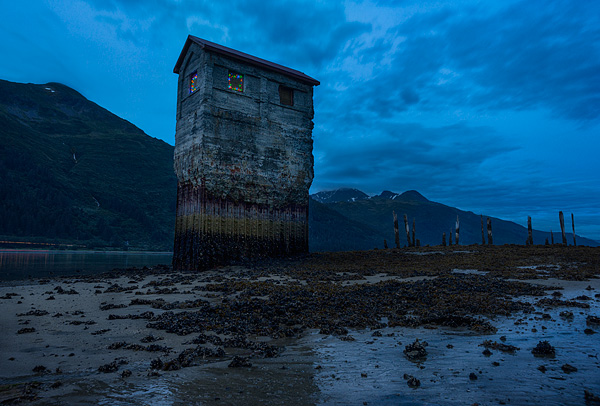
For the next shot, I kept the composition the same but added some light painting. I asked Michelle to stand to the left of the structure and shine a flashlight across the bottom in a slow sweep to help illuminate the pilings. It took a few attempts to balance out the right light. I set the camera to a 2 sec timer so we could take turns shining the light to experiment with different angles. The light was weaker than I would’ve liked as the mud prevented us from getting closer. So I adjusted the exposure time. The settings for this shot were the same as before except the shutter speed was lengthened to 20 seconds in the fast falling light. You can see me lighting the front of the salt pump in the shot below.

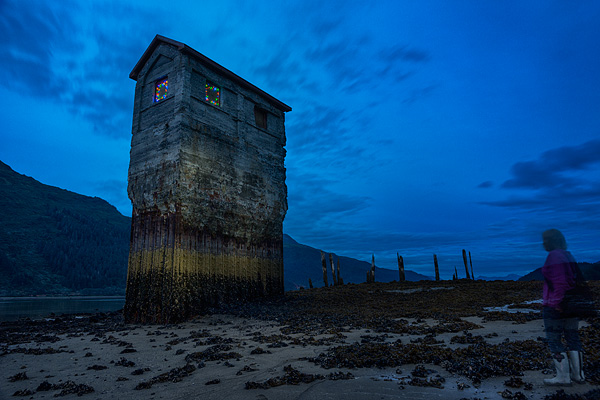
And no, we did not add the Christmas lights in the windows! It is a deserted building in the middle of the water, so who put them there and how they operate without electricity is beyond me! Anybody know?
For the next composition, I walked around the salt pump to position it in front of the city lights of Juneau to the right, and Douglas Island to the left. Again, used a flashlight to light paint the building and pilings, moving from the front to the side of the structure so it didn’t appear one dimensional. Kept the building in the rule of thirds, and the horizon in the lower third. Liked the contrast of the orange lights with the blue sky. Camera settings for this shot: f8, SS 20 sec, ISO 200. I only took one shot. The only difference between this one and the first photo (above) is blurring the clouds in PhotoShop. Had I been more patient I woulda coulda shoulda stayed to take another shot, this time lengthening the shutter speed to maybe 2 minutes or longer to produce streaking of the clouds.

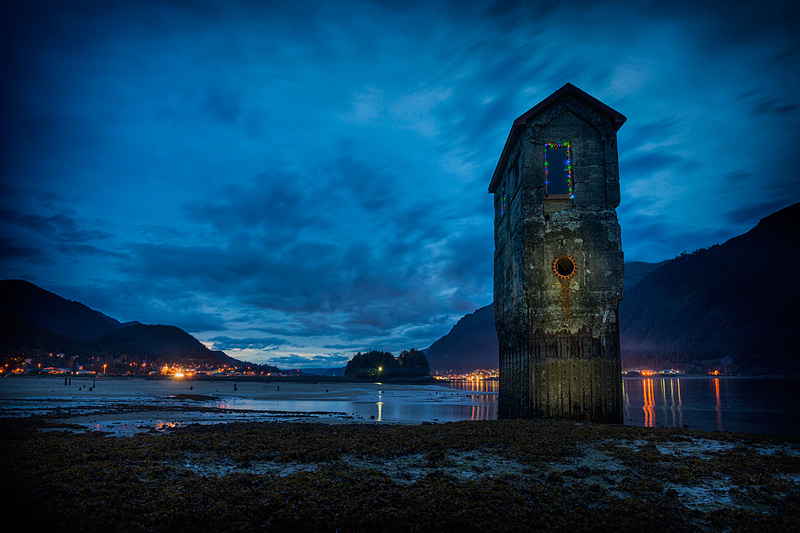
Treadwell Mine salt pump, with city lights from Juneau and Douglas Island
Looking at my raw images at home, I’m surprised to see that I only took 7 shots that night. And just 2 different compositions. There were some short remnants of dock pilings sticking in the sand, and I remember looking through the viewfinder thinking about how I could frame them up in the foreground. But it was getting darker by the minute. I fired off one test shot, trying to light paint the dock pilings.
Scroll down and you can see how dark it was: camera settings and processing in Camera Raw were identical to the shot above. The salt pump was no longer visible. The tiny light on the left was the Christmas lights in the window of the salt pump. Obviously not the right lens. Or camera settings. Sure, I could’ve bumped up the ISO, decreased the fstop, increased the shutter speed…

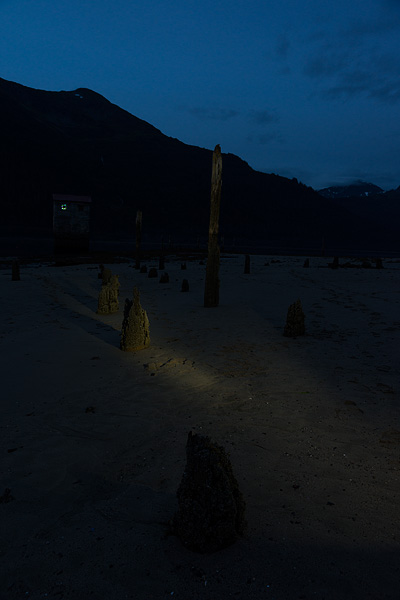
But hunger won out over sticking around and experimenting. So we packed up, even though we’d only been shooting there 20 minutes. We hadn’t had dinner yet and the only restaurant on Douglas Island quit serving at 10pm (or so we thought…when we found it they were closed for the night. We eventually found a tavern serving burgers in downtown Juneau).
The 2nd potential time I’d planned to visit was after dinner much later that same night. Because according to my PhotoPills app, the Milky Way would be directly above the salt pump between 12:30-2am. I could position myself so that it looked like the Milky Way was shooting out of the salt pump. What a unique sight that would be! But as we drove over the bridge to Douglas Island around midnight the clouds were heavy in the sky obliterating any chance of seeing stars or the Milky Way. Bummer!
The 3rd potential time to photograph the Treadwell salt pump was the next day. This time low tide was 1.8 at 11:15am, and high tide of 15.0 would peak at 5:34pm. Since we already captured it at low tide the day before, we decided to go tide pooling elsewhere on Douglas Island in the morning, then spend the afternoon hiking the Treadwell Trail where we would see the salt pump in the middle of the sea during high tide.
Rain poured all day. So I decided to limit my gear to one camera and one 24-70mm lens, wrapped it in a plastic raincover and stuck it inside my camera bag. We spent 2.5 hours hiking the forested trail, taking our time to explore the remaining buildings–like the “new” office building now covered in mossy vegetation. Treadwell was once the most productive gold mine in the USA. Over 70 million dollars worth of gold was mined here before torrential rains caused the mine to collapse in 1917. We saw rusty remnants of mining machinery scattered on the forest floor and even growing out of trees. When the trail began to parallel the shore, I was on full alert for the salt pump. And then, there it was, peeking through the weeds!

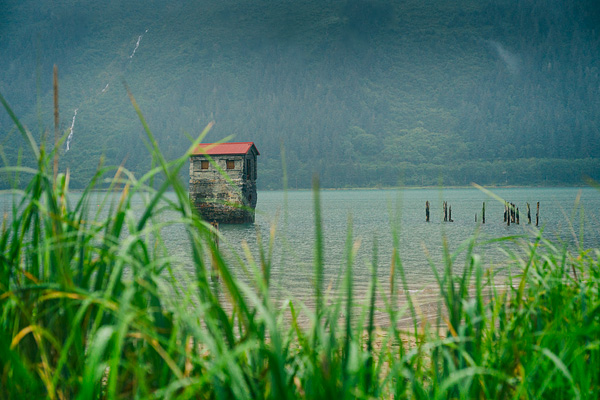
Now stranded in water, and seen from a higher angle, the salt pump didn’t look as menacing. I chose a wide aperture to keep the focus on the structure and let the weeds go soft to decrease the distraction. Camera setting: f4, SS 1/500, ISO 400. Walking closer, and framing the waves gently lapping ashore, the scene became rather tranquil. Camera setting: f11, SS 1/45, ISO 400.


The beach had more dock remnants than I had seen in the dark. I experimented a bit trying to frame them in the foreground and to the side of the salt pump…

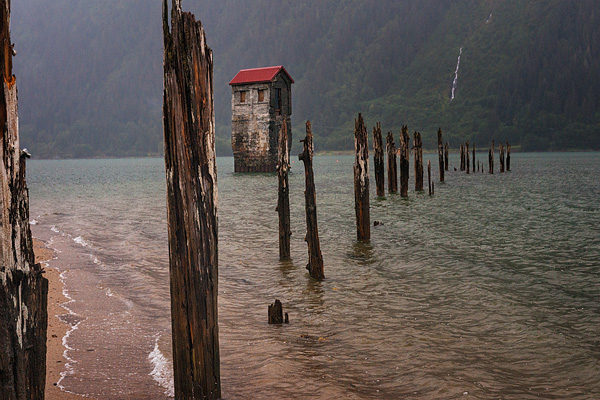
Eh. Not my favorites.

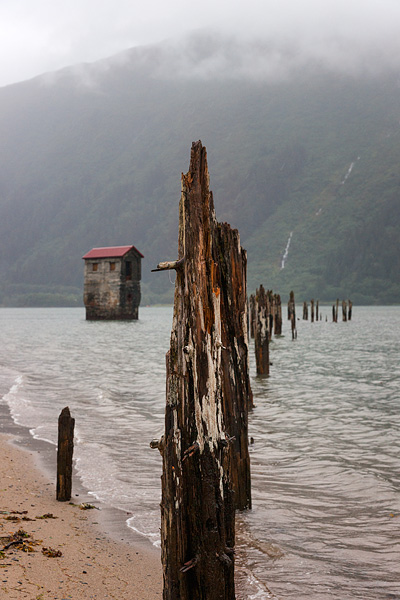
We kept walking and the salt pump soon faded from view. Further along the coast, we came to another line of wooden poles isolated at sea. When my sister waded out to photograph them, she became the missing element. Snap! Thanks sis for providing a sense of scale to the scene. Didn’t know I took your photo, did you? And what–you don’t remember that sunset? It was pouring rain, you say?

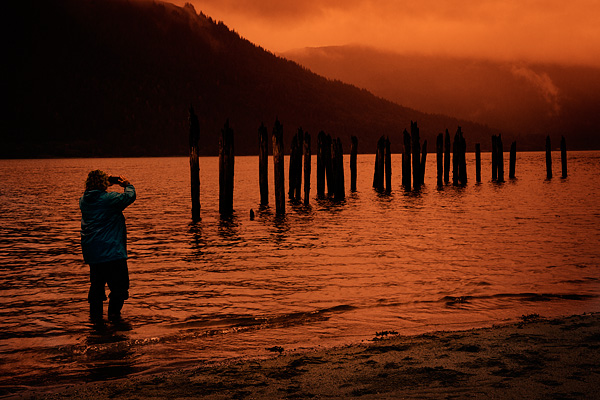
OK. So it was. The scene was just–plain gray. Couldn’t let that be the final image of the day. So I just added a little color in PhotoShop. Why not? I’m sure Juneau gets incredible sunsets. Sometime! (Just having a little fun…) In all seriousness, I could do without all the rain, but I actually prefer their cloudy days to sun. And I truly loved my time in Juneau.
Know before you go:
Tides vary greatly in this part of the world. There can be a difference of 18 feet between low and high tide. Know the tides for your travel dates. You certainly don’t want to get trapped by rising water. Google the tide table for the month you plan to visit Juneau.
Wear rain boots. Even if it’s not raining. Low tide sand turns to muck. Bring rain gear for your camera. I used a very simple drawstring plastic bag that I ended up cutting smaller, and attached it to my lens using a rubber band. Worked well and didn’t take up any room. I also bought a stiff heavy duty plastic rain cover designed for an SLR camera in varying lengths to fit short to long zoom lenses. But it was so cumbersome to use that I kept leaving it in the hotel room, and eventually, just left it there.
Research your destination. Check out images on stock sites prior to your trip, or postcards once you arrive, to see what piques your interest at a location. Study what’s been done before and think about what you could do to capture it differently.
Know the sunrise and sunset times, and that special magic hour (which is 30 minutes before sunrise, and 10 minutes after sunset).
Throw a flashlight in your pack. Doesn’t take much room but can add a nice touch to illuminating a scene. Take time to experiment with different angles and lenses (when it’s not raining). And if you visit in August on a clear night, please use PhotoPills to look up the time that the Milky Way is positioned over the salt pump and go take a shot for me!! (shoot me an email… I’d love to see it. )


